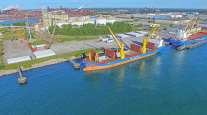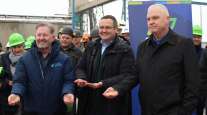San Diego Port Unveils Nation’s First All-Electric Tugboat

[Stay on top of transportation news: Get TTNews in your inbox.]
The nation’s first all-electric tugboat has docked at the Port of San Diego and expects to begin emissions-free operations in about a month.
Operated by Crowley Maritime Corp., the 82-foot eWolf will escort ships entering and leaving the Tenth Avenue Marine Terminal using electric power instead of diesel fuel, helping slash greenhouse gas emissions at the port and its neighbors in Barrio Logan and National City.
“This is a big deal,” said port chairman Frank Urtasun at a news conference March 11. “This is new technology.”
Capable of speeds of up to 12 knots, the eWolf is powered by a 6.2 megawatt-hour main propulsion battery and two electric drives. The tug has thrust — also known as bollard pull in the parlance of the shipping industry — of 76.8 short tons, which is more powerful than the diesel-powered counterparts at the port.

Urtasun
Constructed in Alabama, the eWolf is equipped with two small generators for emergency use that allow the boat to travel longer distances at a reduced speed.
“Like an electric car, you step on the gas and it jumps,” said Paul Manzi, vice president of Crowley Shipping, based in Jacksonville, Fla. “All of the attributes that you have with an electric motor operation in a car or in an electric truck, you see here in the [eWolf] at massive scale. And it’s extremely quiet, so when it pulls away from the dock you literally won’t hear any noise.”
The tugboat’s electricity will come from a charging station that is part of a microgrid facility equipped with two energy storage containers. Battery modules in each container have storage capacity of nearly 1.5 megawatt-hours.
Interconnected with the help of San Diego Gas & Electric, the charging station at the port is designed to allow the vessel to recharge quickly and reduce peak loads on the electric grid.
Operators plan to charge the eWolf overnight so it can perform its chores during daytime hours.
“This technology has individually been around for a while, but it hasn’t necessarily been integrated and optimized to all work together — and that’s kind of our role,” said Bruce Strupp, vice president at ABB Marine & Ports, the company that designed the boat’s propulsion system. “Some of the technology is our technology, some of it’s third-party technology, but we integrate it all together.”
The electric tugboat is expected to begin commercial operations at the port in mid- to late-April, depending on the completion of the charging station.
Officials at Crowley did not release the eWolf’s price tag, saying only that it cost about twice as much as a conventional diesel-powered tugboat of comparable size.
But, Manzi said, the company expects the eWolf’s maintenance and operating costs will be “dramatically lower” than what’s spent on a diesel-powered tugboat because the electric model has fewer moving parts.
The federal government also contributed a $17.8 million grant to the project.
Want more news? Listen to today's daily briefing above or go here for more info
In 2020, California Gov. Gavin Newsom signed an executive order that directed state agencies to transition off-road vehicles — including tugboats — and equipment to 100% zero emissions by 2035.
By replacing one of the port’s diesel-powered tugs, the eWolf is expected to eliminate the consumption of about 35,000 gallons of diesel fuel per year. In its first 10 years of use, the electric tugboat is expected to reduce about 3,100 metric tons of carbon dioxide from the port and its surrounding areas.
“We’re trying to be good neighbors and trying to be able to help to reduce emissions here to help the electrification movement,” Urtasun said, adding that the port has spent about $130 million on various electrification projects.
Last year, the Port of San Diego became the first in North America to install a pair of all-electric cranes to load and offload heavy cargo. Each 262 feet high, the cranes replaced an older crane that ran on diesel fuel. Together, the cranes expect to help the port reduce greenhouse gas emissions by 47 metric tons per year.
Distributed by Tribune Content Agency, LLC




